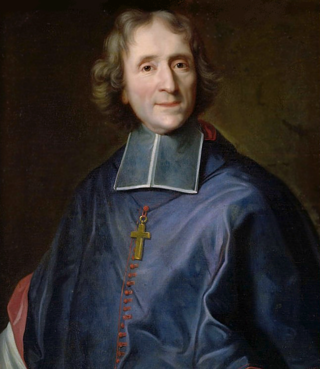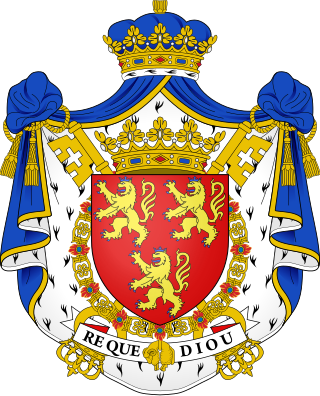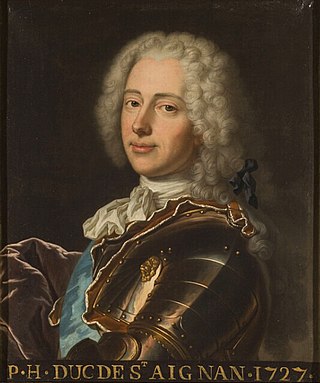Related Research Articles

The Château de Chaumont, officially Château de Chaumont-sur-Loire, is a castle (château) in Chaumont-sur-Loire, Centre-Val de Loire, France. The castle was founded in the 10th century by Odo I, Count of Blois. After Pierre d'Amboise rebelled against Louis XI, the king ordered the castle's destruction. Later in the 15th century Château de Chaumont was rebuilt by Charles I d'Amboise. Protected as a monument historique since 1840, the château was given into state ownership in 1938 and is now open to the public.

François de Salignac de la Mothe-Fénelon, more commonly known as François Fénelon, was a French Catholic archbishop, theologian, poet and writer. Today, he is remembered mostly as the author of The Adventures of Telemachus, first published in 1699.

Marie Anne de La Trémoille, princesse des Ursins, was a French courtier and royal favourite known for her political influence, being a de facto ruler of Spain from 1701 until 1714. She spent most of her life as an agent of French influence abroad, at first in Rome, and then in Spain under the new Bourbon dynasty, followed by a final period at the exiled Stuart court in Rome. She played a central role in the Spanish royal court during the first years of the reign of Philip V, until she was ousted from the country following a power struggle with the new queen consort, Elisabeth Farnese.
Saint-Aignan may refer to :

Louis, Dauphin of France, Duke of Burgundy, was the eldest son of Louis, Grand Dauphin, and Maria Anna Victoria of Bavaria and grandson of the reigning French king, Louis XIV. He was known as the "Petit Dauphin" to distinguish him from his father. When his father died in April 1711, the Duke of Burgundy became the official Dauphin of France. He never reigned, as he died in 1712 while his grandfather was still on the throne. Upon the death of Louis XIV in 1715, the Duke of Burgundy's son became Louis XV.

Paul de Beauvilliers, count and later (1679) 2nd duc de Saint-Aignan (1648–1714), often referred to as the duc de Beauvilliers, was a French government official under King Louis XIV.

François-Honorat de Beauvilliers, 1st duc de Saint-Aignan, born in Paris, was a French military leader, administrator and man of letters. He was peer of France and a member of the Académie française.

Créquy is a French noble family which originated in Artois.

The House of Talleyrand-Périgord was an ancient French noble house. A well-known member of this family was Charles Maurice de Talleyrand-Périgord (1754–1838), who achieved distinction as a French statesman and diplomat. The family name became extinct in 2003 upon the death of Violette de Talleyrand-Périgord.
Charles P. de Saint-Aignan is an American software engineer who works for IBM on the IBM Watson project. He graduated from St. Paul's School, in 1995, followed by Brown University, in 1999.

Claude de Mesmes, comte d'Avaux (1595–1650) was a 17th-century French diplomat and public administrator. He was sent in various missions to Venice, Rome, Germany, Sweden, Denmark, and Poland by Richelieu.

Jean-Jacques de Mesmes, comte d'Avaux, vicomte de Neufchâtel (1630–1688) was a French magistrate, intendant of Soissons, and Président à mortier of the Parlement of Paris. He developed the town of Avaux-la-Ville, which is now called Asfeld. He was a member of the Académie française. He was brother of Jean-Antoine de Mesmes, the diplomat, and father of Jean-Antoine de Mesmes, the premier president of the Parlement of Paris.

Paul-Hippolyte de Beauvilliers, duke of Saint-Aignan was a French diplomat, soldier, chevalier des ordres du Roi and peer of France.

Aignan or Agnan (358–453), seventh Bishop of Orléans, France, assisted Roman general Flavius Aetius in the defense of the city against Attila the Hun in 451. He is known as Saint Aignan.

Duke of Saint-Aignan was a title of nobility in the peerage of France created by Louis XIV of France for François de Beauvilliers in 1663. It takes its name from Beauvilliers' hometown of Saint-Aignan.

The Hôtel de Saint-Aignan, originally the Hôtel d'Avaux, is a 17th-century hôtel particulier, located at 71 Rue de Temple, in the 3rd arrondissement and the Marais district of Paris. It was constructed 1644–1650 to the designs of the architect Pierre Le Muet for Cardinal Mazarin's Superintendent of Finances, Claude de Mesmes, Comte d'Avaux, and later purchased by Paul de Beauvilliers, Duc de Saint-Aignan, who added the grand staircase. It is now the home of the Musée d'Art et d'Histoire du Judaïsme.

Victurnien Jean-Baptiste Marie de Rochechouart, prince of Tonnay-Charente then 9th duke of Mortemart was a French general and politician. He came from the Mortemart branch of the house of Rochechouart, named after the barony of Mortemart in Haute-Vienne, later raised to a marquisate and finally in December 1650 to a peer-duchy.

Marie-Catherine de Beauvilliers was a French abbess.
Anne Marie de Bethune (1610-1688), was a French court official. She served as the dame d'atour to the queen of France, Maria Theresa of Spain from 1660 to 1683. She was a central figure in the French royal court and mentioned in contemporary memoirs.
References
- This article incorporates text from a publication now in the public domain : Chisholm, Hugh, ed. (1911). "Beauvillier". Encyclopædia Britannica . Vol. 3 (11th ed.). Cambridge University Press. p. 599.